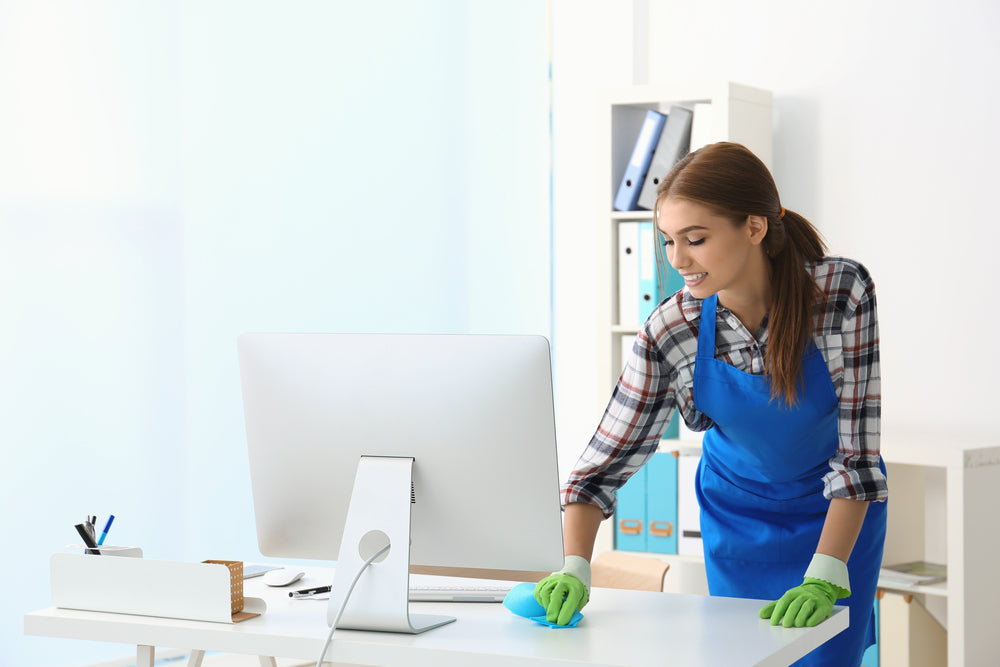With spring just around the corner, or even having already arrived in some areas of the country, spring cleaning is a topic for many home and building owners alike. If you're the owner of a company or even just an office manager, you might be thinking about some spring cleaning for the office space -- and cleaning various furniture pieces is a part of this process that should not go overlooked.
At Urban 9-5, we're not just here to offer the very best modern office furniture products, from desks and tables to seating options and more, but also to assist our clients with long-term maintenance and care tips for any of our pieces -- including cleaning needs. When it comes to spring cleaning, here are some basics tips on how to handle various furniture materials that might be present in your office space, ensuring they're cleaned properly alongside other areas.
Cleaning Laminate Furniture
If your office contains furniture that utilizes laminate surfaces, you'll want to pay special attention to the care of this type of material -- most notably when it comes to cleaning. With laminate furniture pieces in particular, be sure to avoid using any harsh or abrasive cleaners that could potentially damage or discolor the surface.
Here are some simple tips on a few common cleaning areas within the laminate world:
- Dusting: When dusting laminate surfaces, you should use an oil-free dusting spray to avoid any potential staining. Additionally, a microfiber cloth should be used when dusting with a laminate furniture piece in order to help maintain cleanliness and avoid harsh particles from reaching the surface of the product.
- Hand washing: There are many laminate pieces that will do very well with hand washing, so if you spot any potential spills or stains, be sure to monitor them closely. With most hand-washable furniture, you should utilize a damp cloth for cleaning purposes along with some gentle soap in warm water -- but avoid soaking the surface of your product if at all possible.
- Stain removal: If you need to remove stains from a laminate surface, the primary method here is using hot water and baking soda to create a paste -- then applying this mixture to the stained area until the location is fully saturated. Allow this paste to dry, then use a damp cloth or sponge to remove it from the laminate surface. Don't forget to rinse the area once you're done!
Cleaning Vinyl Furniture
Vinyl is another product that's become enormously popular in the furniture world, and with good reason -- vinyl is easy to work with and helps bring a high-end style to any home or office space. However, it's not indestructible, so proper care should be taken in order to ensure your vinyl pieces remain in good shape for as long as possible.
Vinyl is a product that requires a specific solution to clean it in most cases. There are a couple solutions sometimes used:
- Baking soda and water: Mix enough baking soda in water to create a paste, then apply it directly to the surface of your vinyl furniture piece. After allowing this mixture to sit on the product for several minutes, clean it away with an absorbent cloth or sponge (this is very similar to removing stains from laminate).
- Vinegar, warm water and oil soap: This solution for cleaning vinyl involves a half-cup of warm water, a half-cup of vinegar, and two teaspoons of a quality oil soap (for instance, Murphy's Oil Soap does the trick). This solution will then be applied with a damp cloth.
Cleaning Steel or Metal Furniture
Many of our top industrial furniture pieces involve steel or other metal components -- so what's the best way to keep these surfaces looking their very best?
When cleaning metal surfaces, it can be a bit more challenging than for other types of furniture. For starters, avoid any harsh chemicals and abrasives that could potentially damage or rust the surface. Here are a few basic tips on how to handle steel and other metal pieces:
- Always avoid steel wool or anything abrasive when it comes to cleaning metal office furniture.
- Using an oil-based furniture polish for metal surfaces is usually the best idea, allowing you to keep your product looking sleek and shiny without worrying about rust or other blemishes forming. Oil-based polish can be applied with a soft cloth (like microfiber) and will help to protect the metal components from any damage or rust.
- Be sure to consider the cleaning solutions that are best for your laminate furniture pieces when you're looking to clean more than just metal -- there's no reason to risk damage to any area of your office space.
Cleaning Leather Furniture
Finally, cleaning leather is similar in some ways to cleaning vinyl -- but with more options at your disposal in most cases. Some of the possible methods for cleaning leather furniture include:
- Specific leather cleaner: If you have a cleaner that's specific to leather surfaces, this is usually your best option.
- Vinegar and linseed oil: The mixture of one part vinegar with two parts linseed oil can be applied to a leather surface, then cleaned away after it has been allowed to remain for several minutes.
- Rubbing alcohol and water: In other cases, a mixture of one part water with three parts alcohol can be applied to a leather surface.
- Cuticle remover: If you have pen marks and similar stains on your leather, a cuticle remover can often remove these issues. However, it's important to be careful when using this solution -- you don't want to damage your product.

